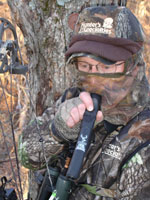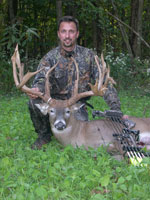Calling All Deer with Dr. Larry Marchinton
Rattling Antlers
 Editor’s
Note: What is a hunter saying to a deer when the woodsman
blows a call? What calls are the most effective? What
actually is meant by the sound that the hunter is trying
to imitate? Although every hunter and each call manufacturer
has his own notion, at the University of Georgia in
Athens, Georgia, the sounds that whitetail deer make
and what they mean by these sounds have been scrutinized
carefully by a team of scientists that included Dr.
Larry Marchinton, the former head of the University
of Georgia’s Deer Research Project, who’s
now retired. This week Dr. Marchinton shares hi Editor’s
Note: What is a hunter saying to a deer when the woodsman
blows a call? What calls are the most effective? What
actually is meant by the sound that the hunter is trying
to imitate? Although every hunter and each call manufacturer
has his own notion, at the University of Georgia in
Athens, Georgia, the sounds that whitetail deer make
and what they mean by these sounds have been scrutinized
carefully by a team of scientists that included Dr.
Larry Marchinton, the former head of the University
of Georgia’s Deer Research Project, who’s
now retired. This week Dr. Marchinton shares hi s
research on deer vocalization. s
research on deer vocalization.
To give an overview of deer calling, we must not only
mention deer vocalization but also take a passing look
at rattling antlers. Marchinton feels that antler rattling
falls into two categories – sparring matches and
buck fights. According to Marchinton, “Sparring
matches, which are not true fights, usually take place
early in the season right after the velvet is shed from
the buck’s antlers. During this testing time,
each buck learns what his position is in t he
herd, and deer form their pecking order. As the season
progresses, and the does go into the rut, there often
will be full-blown fights. The fights occur when two
dominant bucks or two bucks that think they’re
dominant come into conflict because of a doe, which
is when the all-out battles occur. Once you understand
the differences in the two types of deer fights, you
have to adapt the severity of your rattling techniques
to the time of the year you’re hunting. If you’re
hunting early in deer season when the bucks are forming
their pecking order, then tinkling the antlers –
just lightly hitting the tips together and not clashing
the antlers together nearly as hard as you will later
in the season – is best. If you’re rattling
during the rut, you need to clash the antle he
herd, and deer form their pecking order. As the season
progresses, and the does go into the rut, there often
will be full-blown fights. The fights occur when two
dominant bucks or two bucks that think they’re
dominant come into conflict because of a doe, which
is when the all-out battles occur. Once you understand
the differences in the two types of deer fights, you
have to adapt the severity of your rattling techniques
to the time of the year you’re hunting. If you’re
hunting early in deer season when the bucks are forming
their pecking order, then tinkling the antlers –
just lightly hitting the tips together and not clashing
the antlers together nearly as hard as you will later
in the season – is best. If you’re rattling
during the rut, you need to clash the antle rs
together with a lot of force and grunt to simulate a
full blown buck fight. But, once again, rattling antlers
is not a sure-fire way to bring in a dominant buck.
I’ve seen dominant bucks that were tending does
actually veer away from fights. Researchers believe
that they move away from a fight to keep from losing
the doe that they’re tending.” rs
together with a lot of force and grunt to simulate a
full blown buck fight. But, once again, rattling antlers
is not a sure-fire way to bring in a dominant buck.
I’ve seen dominant bucks that were tending does
actually veer away from fights. Researchers believe
that they move away from a fight to keep from losing
the doe that they’re tending.”
Although information about deer vocalization and deer
calling will make you more knowledgeable about the deer
you hunt, all hunters should remember that deer calling
is not a magic cure-all. Calling deer doesn’t
replace the hunter’s knowledge of the animal or
the hunter’s woodmanship. The ability to call
deer is just another aid that on certain days under
specific conditions may bring a buck in to where a hunter
is.
|
